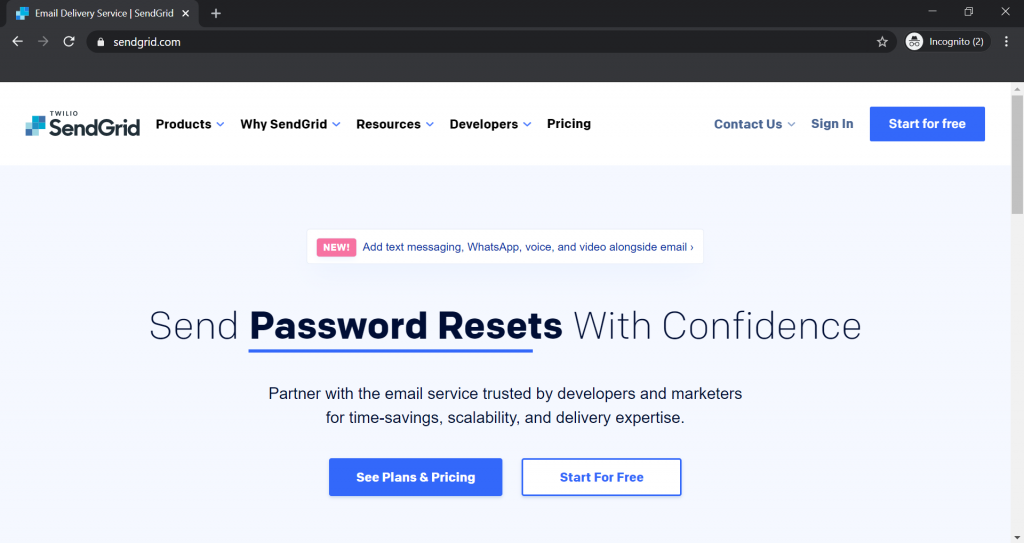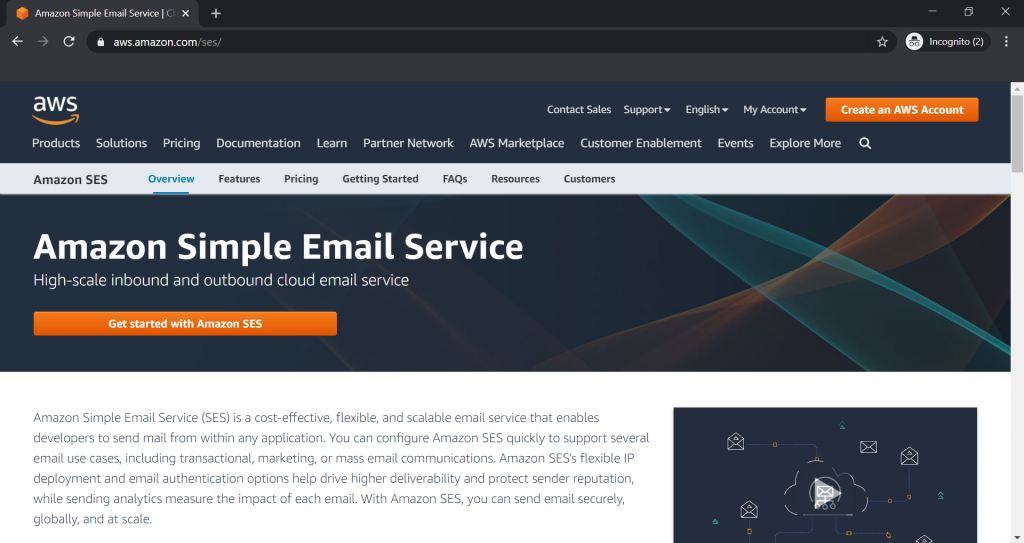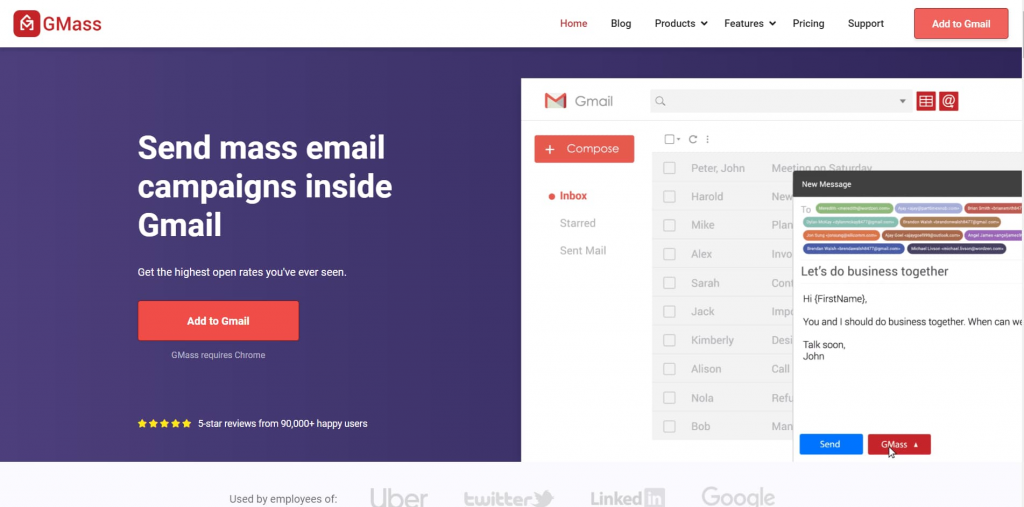
Interested in learning about transactional email?
Transactional emails are automated emails sent in real time from a mobile app, web app, or website. Usually delivered through specialized transactional email services, these emails are responses to user interactions on your application or website.
In this article, I’ll help you understand what transactional emails are, who uses them, their key benefits, and how to send them.
This Article Contains:
(Click on a link to jump to a specific section.)
- What Is a Transactional Email?
- Why Use Transactional Emails?
- Where to Use Transactional Emails
- How to Send Transactional Emails
- Two Popular Transactional Email Services
- FAQs about Transactional Emails
Let’s get started.
What Is a Transactional Email?
A transactional email is an automatic message sent to a user based on specific actions they performed on your website, web app, or mobile app.
Transactional emails are user-triggered, automated, one-to-one responses generated in real time.
Common examples of transactional emails are password reset emails, account confirmation emails, and shipping confirmation emails.
How are transactional emails sent?
Transactional emails are sent using transactional email services, like SendGrid and Amazon SES.
For example, let’s say you own an e-commerce website where a customer adds an item to their cart but doesn’t check out.
You can set up an email to be sent automatically to remind them of what they left in their cart, asking them if they’d like to complete the purchase. In this scenario, the email would be a transactional email.
Cart abandonment emails are a great strategy to re-engage customers and encourage sales if customers have questions about the product or became distracted before completing their purchase.
Who Uses Transactional Emails?
E-commerce websites aren’t the only sites that use transactional emails.
Here are some other ways that transactional emails are used:
- Banks use transactional emails to send updates on amounts debited from or credited to your account.
- Companies like Google, SaaS tools, and social media platforms like Facebook, etc. use transactional emails to send you password reset instructions and new device login alerts.
- Delivery services use transactional emails to provide real-time information about packages in transit.
Why Use Transactional Emails?
Here’s a closer look at the two key benefits of using transactional emails:
1. Improve Customer Experience
Transactional emails are one of the easiest ways to improve customer experience on your site or app.
Let’s say you’ve purchased a product online.
The website charged your credit card, and the order was estimated to be shipped in two to five business days.
And then, dead silence.
Was your order packed and shipped?
Is it getting held up somewhere?
How do you know?
However, let’s say the website sends automated updates on shipping details via transactional emails. This way, you don’t have to call customer support or take any time to follow-up on the status or your order. And the business doesn’t have to take tons of calls about when customers can expect their products and services.
2. Can Help You Generate Increased Sales Opportunities
Transactional emails are used to send important, one-to-one communications to a user, which is why they have a better chance of being opened by the customer.
Customers may open transactional emails to skim through updates, scan for any useful information, take action, and so on.
This high level of customer engagement gives you an incredible opportunity to upsell or cross-sell products, remind customers about the latest deals, or engage them in other ways.
For example, order confirmation emails can be used to advertise related products that customers might find interesting.
Where to Use Transactional Emails
Successful transactional emails are non-promotional in nature and are critical to users.
But where do you use them?
Here’s a quick look at six everyday use cases for transactional emails:
1. Account Creation Emails
If your website or mobile app requires users to create an account and sign in, you can set up transactional emails as responses to successful account creation.
The email would confirm that an account was created and guide the user on what to do next.
2. Password Reset Emails
A password reset email is sent to your inbox when you forget your password; it usually contains a unique link for you to create a new password.
These quick password reset emails are essential to ensure that your users have a way to access their accounts if they forget their log-in credentials.
3. App Notification Emails
Certain types of websites and applications send you updates based on your activities there.
These notifications might be intended to direct your attention to a particular update or improve your engagement with the service.
For example, let’s say you’ve signed up for a social network like LinkedIn.
You might receive notification emails about relevant job alerts based on your interests, the names of people who have viewed your profile, or comments from other members on a post you’ve shared.
4. Order Confirmation Emails
Most e-commerce websites automatically send confirmation emails when an order has been successfully placed.
The order confirmation mail might contain the item details, shipping and billing addresses used, pricing breakdown, and more. The order confirmation might also confirm some contact details for the customer, should they happen to have any inquiries.
Order confirmation emails are a great place to show, upsell, and cross-sell related products that customers might find interesting.
5. Shipping Status Emails
No customer wants to be left in the dark about their online order deliveries. And that’s why delivery services use shipping status emails to keep their customers informed about the whereabouts of their deliveries.
Shipping status emails are crucial for excellent customer experience since they offer transparency, enforce accountability, and help manage customer expectations.
6. Event Reminder Emails
Event reminder emails can be used in several contexts.
For example, let’s say a customer used your website to book tickets to an event.
A day before the event, you could send an email reminder to your attendees, reconfirming the venue and itinerary, repeating the link where they can access their tickets, and so on.
Retail outlets also use these types of transactional emails to bring your attention to the beginning or closing of a sale.
Besides the types of transactional emails I’ve covered in detail here, you also have:
- Product review emails
- Trial expiry emails
- Terms and conditions update emails
- Unsubscribe completion emails
- Delivery confirmation emails
- Legal update emails
- Invoice and receipt emails
- Subscriber welcome emails
How to Send Transactional Emails
Transactional emails are crucial to any business strategy — especially if your customer journey involves using web or mobile applications.
But how do you send them?
There are two ways to send transactional emails:
Here’s a quick look into each method:
1. Using an SMTP Service
An SMTP (Simple Mail Transfer Protocol) service allows you to bypass the email sending limits placed by your email service provider (like Gmail) for sending bulk emails.
For example, if you’re using a regular Gmail account to send transactional emails, there’s a 500 email/day limit.
That’s a significant roadblock if you need to send more than 500 transactional emails in 24 hours — especially if your business is booming.
Using a third-party SMTP service, you can send unlimited transactional emails from your account without getting your account suspended by the service provider.
Read my ultimate guide to SMTP.
2. Using an Email API
An email API (Application Programming Interface) helps you access the functionalities of an email marketing platform or transactional email service directly from your website, web app, or mobile app.
You don’t have to send transactional emails to each customer or subscriber manually.
Instead, just set up workflows to send automated responses based on user-interactions on your application or service.
What should you choose: SMTP or API?
Most transactional mail services offer both email API and SMTP services to send transactional emails with good email deliverability.
Consider these points when choosing between email API and SMTP for your transactional emails:
- Email APIs are generally faster since there are fewer back-and-forth data exchanges when compared to an SMTP service.
- SMTP is a standard protocol and is used universally by email marketers — making it easier to connect with an existing application like a CRM (Customer Relationship Management) system or a mail client such as Gmail or Outlook.
- Email APIs offer extra security by using API keys that allow only your website or application to perform email tasks.
In a nutshell, SMTP is a great option for a regular email marketer, while email APIs work well for those who have coding expertise (since using APIs require technical know-how).
Two Popular Transactional Email Services
Here are two excellent transactional email services that help you leverage SMTP and email API capabilities:
1. SendGrid
Twilio SendGrid is a cloud-based SMTP relay service provider and email marketing platform that allows you to send both marketing and transactional emails.
It aims for good deliverability, ensuring that your transactional emails end up in the recipients’ inbox and not in the spam folder.

Read my in-depth SendGrid review.
SendGrid Key Features
- Easy transactional email integration with your mobile app or website using the SMTP setup or its flexible APIs
- Built-in analytics and reporting on transactional email delivery metrics such as the number of emails clicked, open rate, bounce rate, and more
- Multiple features like a dedicated IP address (based on your needs), email authentication, sender reputation monitoring, A/B testing, and webhooks to achieve better email deliverability
SendGrid Limitations
- Confusing user-interface as many features aren’t visible at first glance
- Limited features in the SendGrid basic plan
SendGrid Pricing
- Free plan supports 40,000 emails for the first month, after which you can send 100 emails/day
- Paid plans start at $14.95/month for 50,000 emails
2. Amazon SES
Amazon SES (Simple Email Service) is a flexible cloud-based SMTP service that allows you to send transactional emails and marketing content.

Check out my in-depth Amazon SES review.
Amazon SES Key Features
- Cost-effective delivery of transactional emails using their SMTP service or email APIs
- Integrates with different web applications and platforms like Stripe, Gmail, and WordPress
- Detailed performance reports showing email deliverability, bounce, and delivery rates
Amazon SES Limitations
- Requires advanced technical know-how
- Limited SMTP capabilities
Amazon SES Pricing
Amazon SES offers a pay-as-you-go plan that supports 62,000 emails/month for free when Amazon SES is called from an application hosted in Amazon EC2 (Elastic Compute Cloud).
It charges $0.10 for every 1,000 additional emails sent after the 62,000 email sending limit is reached via that hosted application.
Want to check out more transactional email services? Read my detailed reviews of:
- SendPulse
- Moosend
- Inboxroad
- SMTP2GO
- Sendinblue
- SocketLabs
- SMTP.com
- Mailgun
- Mailjet
- Mandrill (by Mailchimp)
Do Transactional Email Services Give You Everything You Need?
Most transactional email services have their drawbacks — especially when it comes to managing your marketing emails.
Remember, transactional emails aren’t the only emails you’ll be sending!
You’ll also have to handle marketing emails, sales emails, and all other kinds of emails to keep your business running smoothly.
Don’t worry. There’s a smart way to enhance all these transactional email services: GMass.
Wait, what’s GMass?

GMass is a powerful email marketing automation platform that works inside Gmail.
Its superior outreach features and advanced email automation capabilities make it a popular tool used by employees in companies like Google and Uber, and social media giants such as Twitter and LinkedIn.
GMass is also perfect for small businesses, churches, solopreneurs, or anyone who uses Gmail.
Here’s how GMass enhances transactional email services:
- Can send personalized bulk emails to your subscribers
- Can set up automated follow-ups for sent emails
- Helps you reach out to customers via a cold email and drip marketing campaigns
- Uses GMass add-on to manage email campaigns from a Gmail Android app
- Gives you access to real-time reporting and analytics on your transactional emails
To use GMass, download the Chrome extension and sign up with your Gmail account for free.
It’s that easy!
Read my guide on Gmail SMTP settings to see how you can connect GMass to your transactional email service.
FAQs about Transactional Emails
Let me provide some detail about two commonly-asked questions related to transactional emails:
1. What Is the Difference Between a Transactional Email and a Marketing Email?
Transactional emails are personalized, one-to-one automated emails sent to a specific individual from a website or mobile application based on that person’s real-time interactions.
They contain crucial dynamic content related to a specific customer and are generally used for non-promotional purposes.
Marketing emails are one-to-many email messages sent for promotional purposes. Although people may have opted-in to receive marketing emails, these are not user-driven but marketing- or sales-driven.
Not all marketing emails are personalized, and they may follow a uniform email template depending on a company’s needs. Marketing emails can contain information on new product releases, invitations to an event, newsletters, upcoming sales, and so on.
2. What Are the Best Practices for Creating Transactional Emails?
Here are some best practices when creating and sending transactional emails:
- Keep it personalized: Use the customer’s first or last name while sending your automatically-triggered emails to make it personalized.
- Use a concise subject line: Ensure that you keep the subject short, specific, and informative.
- Include a reply-to address: Always include a reply-to address in case the customer has questions, complaints, or suggestions.
- Brand the message: Make sure that your tone during transactional messaging is consistent with your brand by adding logos, images, and any formatting accordingly.
- Set up DKIM and SPF protocols: Prevent malicious senders from sending transactional emails by implementing SPF and DKIM.
Note: SPF (Sender Policy Framework) and DKIM (DomainKeys Identified Mail) are security protocols used to prevent malicious senders from sending emails on your behalf.
Ajay’s Email TipSimple steps, like starting and ending your transactional emails properly, go a long way in improving email open rates. Check out my in-depth guides on how to start and end an email for useful pointers. |
Wrapping Up
Transactional emails are automatically-generated, user-driven emails that contain important information. They help keep your customers and users informed and can also help you upsell and cross-sell products.
You can leverage the SMTP server or email API capabilities offered by transactional email services to send your transactional message with ease. However, it’s important to note these services aren’t enough to handle all your emailing needs. For that, you need tools like GMass.
With GMass, you can do so much more with transactional emails.
From creating automated follow-up workflows to scheduling personalized bulk emails, GMass can help you with all your email marketing needs.
Sign up for GMass today and connect your transactional email service to take things to the next level!
Only GMass packs every email app into one tool — and brings it all into Gmail for you. Better emails. Tons of power. Easy to use.
TRY GMASS FOR FREE
Download Chrome extension - 30 second install!
No credit card required










